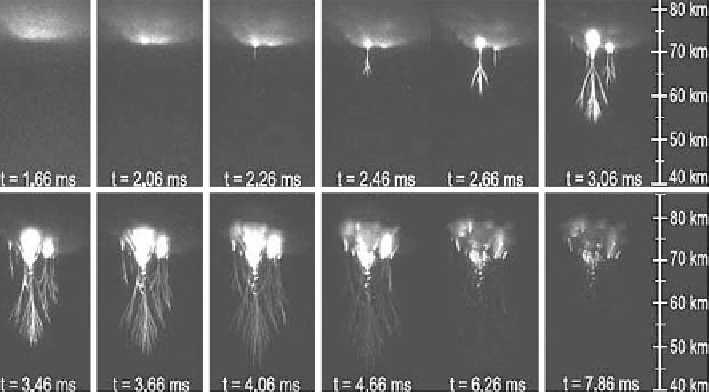Geoscience Reference
In-Depth Information
Fig. 3.19
High speed images of the sprite nucleation. The images were recorded at Yucca Ridge
Field Station on August 13, 2005 at 03:12:32.0 UT. Adapted from Cummer et al. (
2006a
)
might be delayed by several ms after the causative
C
CG discharge while “carrot”
sprites occur tens of ms after the
C
CG lightning (e.g., Matsudo et al.
2009
; Suzuki
et al.
2011
).
The positive CG flashes may result in the extraordinary large charge transfer
(
100 C) for the short time that gives rise to the strong QE field caused by
uncompensated negative charges located in the thundercloud. To estimate this QE
field at high altitudes, consider first a short period just after the causative
C
CG
lightning. In the first approximation this implies that the conduction current,
a
E,
is much smaller than the displacement current, "
0
@
t
E, so that the air conductivity
can be neglected. To simplify the problem, the thundercloud charge is assumed to
be uniformly distributed inside the ball with radius r. The center of the charged
ball is located on
z
-axis at the altitude h above the perfectly conducting ground.
In this model the vertical component of electric fields E
z
on
z
axis is described by
equations similar to Eqs. (
3.2
)-(
3.4
). The thundercloud charge q and QE field can
gradually increase just after the moment of main stroke due to strong CC in the
sprite-associated +CG lightning. This CC is normally much greater than that due
to negative stroke and its value amounts to 5-10 kA for a relatively long period of
10-100 ms (Rakov
2000
). To illustrate this tendency, plots of E
z
versus altitude
z
are shown in Fig.
3.20
with lines 1-3, which correspond to q
D
50, 100, and 150 C,
respectively. In making these plots the numerical values h
D
10 km and r
D
2 km
are used.
We recall that all the threshold fields exponentially decrease with altitude
whereas the QE field caused by the thundercloud charge and its electric image in
the conducting ground falls off according to the dipole law; that is, inversely as the
cube of the distance from the source. This means that the breakdown fields decrease

Search WWH ::

Custom Search